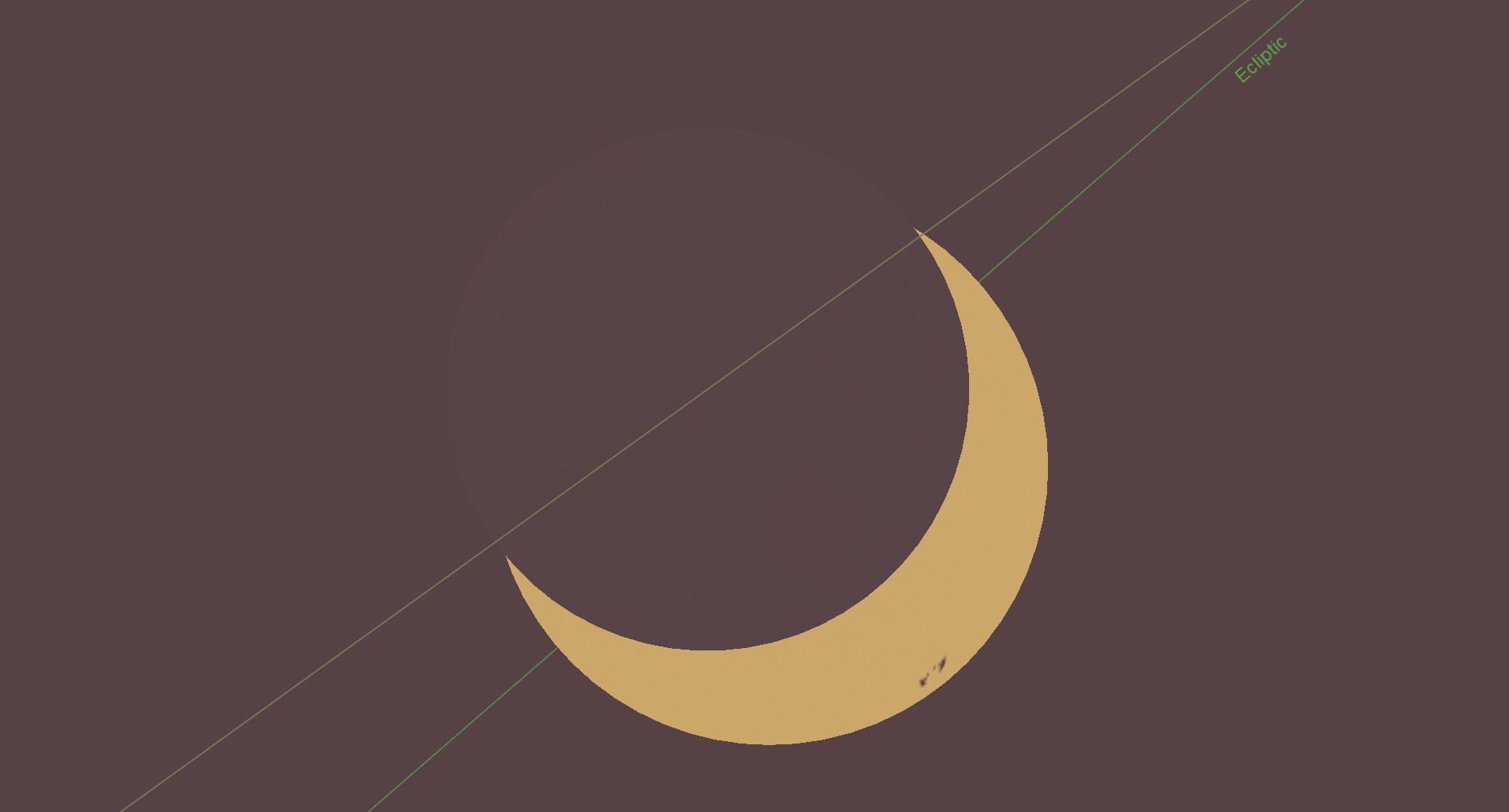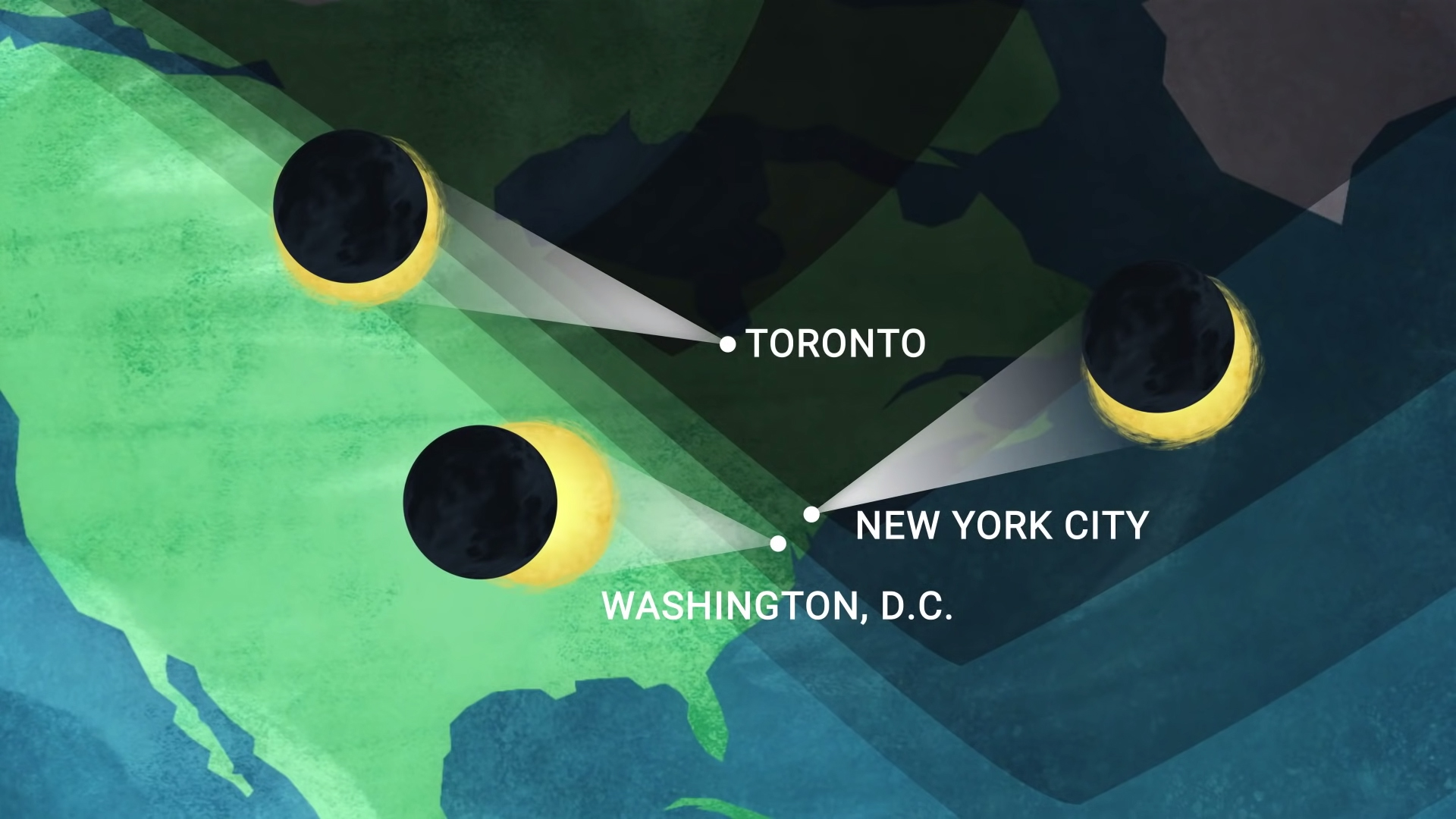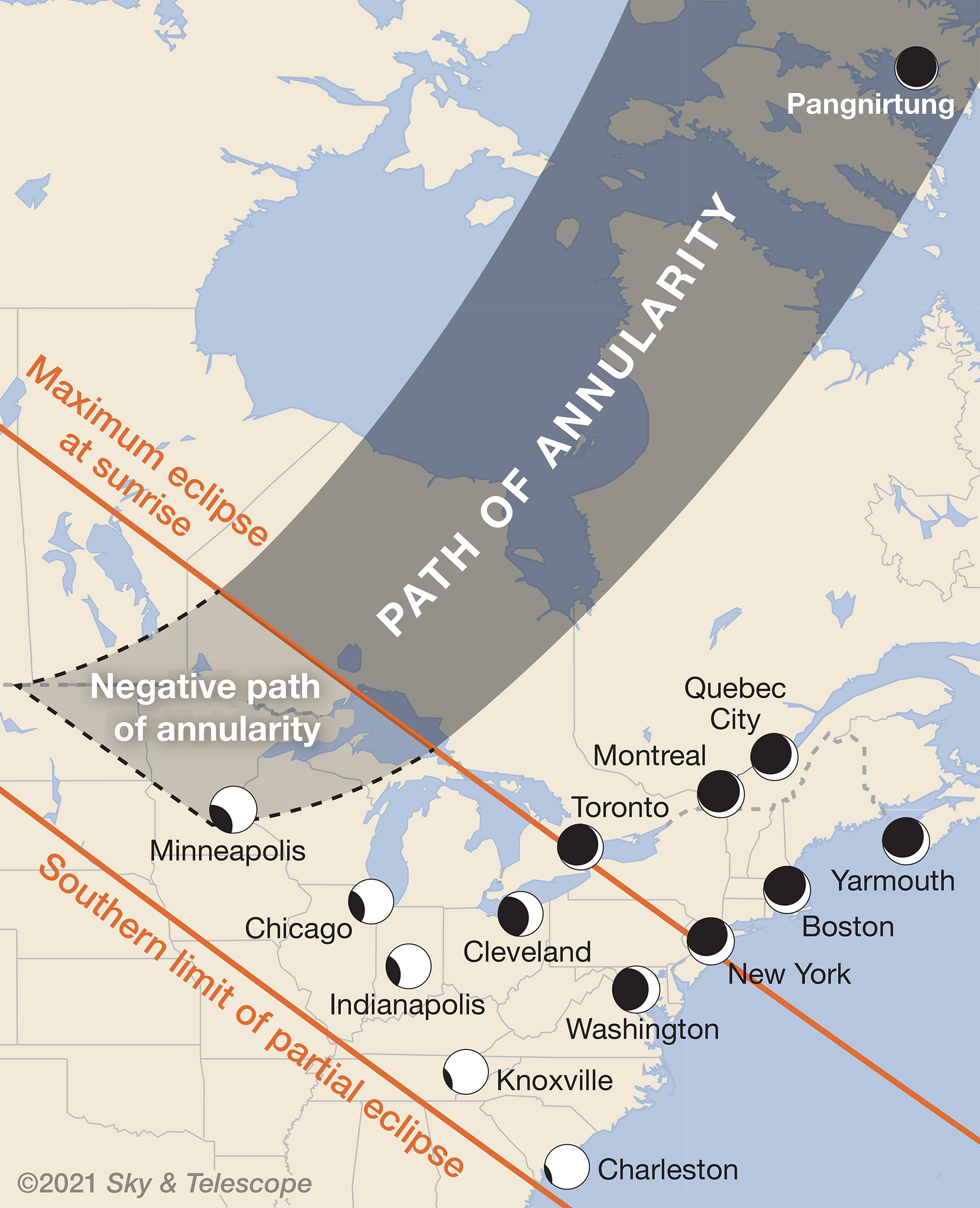
For those who live on the Upper Peninsula of Michigan, or New York State and New England, as well as southern portions of Ontario and Quebec, the sunrise of Thursday (June 10) will bring a striking image of a crescent sun rising in the east-northeast. That's because the moon will be passing across a portion of the sun in the first solar eclipse of the year.
To see the crescent sunrise, find a flat, clear horizon free of any obstructions. It's probably a good idea to do some location scouting in the days before so you're not hastily searching before dawn on the key morning. Some high rooftops or some shorelines may provide just such a view.
With the summer solstice coming only 10 days later, the sun is now coming up at its earliest possible, but it will be well worth foregoing some sleep if the local weather conditions allow.
'Ring of fire' eclipse 2021: When, where and how to see the annular solar eclipse on June 10

If you snap a photo of the 2021 annular solar eclipse let us know! You can send images and comments to spacephotos@space.com.
Many locations will see four-fifths or more of the sun's diameter hidden by the new moon as it emerges from beyond the east-northeast horizon, and with so much of the sun covered, one might wonder whether the eclipse will have any influence on the overall illumination of the sky. Will daybreak seem dimmer compared to a normal morning with a round, full sun shining?
The only way to know is to make sure that you're out there early; check out if the pre-sunrise morning twilight looks creepy, since the eclipse will get underway well before sunup. Atmospheric refraction of sunlight could produce some colorful mirage images at sunrise.
It will probably be too early in the day for the eclipse to dim the landscape — but then again, with so much of the sun covered, sunlight will be coming only from the sun's darker limbs and not as much from its bright disk. So, perhaps the effect won't diminish the brightness of sunlight as much as it will alter its quality; overall illumination may appear strangely "dusky" or amber-colored.
Get the Space.com Newsletter
Breaking space news, the latest updates on rocket launches, skywatching events and more!
Analog studies
It might be worth looking back at past eclipses where a similar fraction of the sun was covered to see what sky effects were noted by observers.
In his autobiography: "Starlight Nights," Leslie C. Peltier wrote of his observation of a partial solar eclipse on June 8, 1918. From his Delphos, Ohio home, the eclipse reached 77.5% coverage. When the eclipse reached its peak, Peltier described the overall scene: "The nearby fields, the distant vistas, all seemed wrapped in some unearthly early twilight. The sky seemed darker — shadows faint and indistinct. A cool wind, almost chilly had sprung up from the west."
For a solar eclipse occurring on March 7, 1970, Sky & Telescope magazine in its May 1970 issue reported observer impressions from a number of locations. From Chicago where the magnitude of the eclipse was 72%, one person commented on the "abnormal blueness of the sky and the deep yellow hue of the weakened sunlight." Another report from Ottawa, Ontario commented that "The surroundings appeared very odd, almost as if illuminated by half a dozen full moons," near mid-eclipse (83%).
Related: Solar eclipse guide 2021: When, where & how to see them

On July 10, 1972, a partial eclipse reached 79.5% coverage over New York City. The next day, according to The New York Times, "Trees and clouds looked as if they were being seen through Polaroid glasses; glare was lessened" at the peak of the eclipse. Interestingly at this upcoming eclipse, the magnitude of the eclipse for New York will be practically the same: 79.7%, eight minutes after sunrise.
The eclipse outside annularity
No place in the United States will see the "ring of fire." However, parts of Minnesota, Wisconsin, and North Dakota, as well as a slice of southeast Manitoba, and southwest Ontario provinces would witness the annular phase — except it happens below the horizon prior to sunrise; a "faux zone" of an annular eclipse.

From Fargo, North Dakota, for example, the ring forms at 4:56:06 a.m. Central Daylight Time and lasts just over three and a half minutes. It's too bad that the sun will be about 6 degrees below the east-northeast horizon! By the time the sun finally comes up at 5:36 a.m., the magnitude will have shrunk to just 26.5% with the moon rapidly retreating off the sun's disk.
The table below provides specifics for five locations very near to or within the "faux annular eclipse path." Provided is the duration of "faux annularity" in minutes and seconds, the time of sunrise and its accompanying magnitude values, along with the time of the end of the eclipse.
| Location | Max. eclipse | Duration | Altitude | Magnitude | Eclipse ends |
|---|---|---|---|---|---|
| Minneapolis, MN | 4:51:19 | — | -5.7° | 30.4% | 5:46:53 |
| Duluth, MN | 4:52:30 | 2m 52s | -3.8° | 52.2% | 5:48:42 |
| Fargo, ND | 4:56:06 | 3m 34s | -5.7° | 26.5% | 5:51:24 |
| Winnipeg, MB | 4:59:42 | 2m 11s | -3.3° | 54.3% | 5:55:48 |
| Minot, ND | 5:01:00 | 2m 21s | -6.3° | 62.7% | 5:55:54 |
All five cases are for where maximum eclipse is around 6 degrees or less below the horizon — a time known as "civil twilight" — when the sky normally becomes bright enough for motorists to turn off their headlights. But on June 10 the skyglow may be quite subdued or perhaps even briefly missing due to the annular phase already in progress. Minneapolis is not within the faux annularity path, but just outside its southern limit.
If any high cloud cover is present along the eastern horizon, the sky may look especially funky. Depending on the sky's clarity and the amount and type of local cloud cover on eclipse morning, perhaps the moon's shadow itself will be evident, projected low on the eastern sky, though most likely any darkening will have no noticeable shape or outline.
It would help to compare what the sky looks like just before sunrise on June 10 to that of June 9 and June 11, especially using a wide-angle camera lens or better yet a video or rapid sequence of photographs of the eastern sky which ultimately could prove to be quite dramatic.
Protect your eyes
It's always a bad idea to stare at the sun without protective equipment, even during an eclipse. To safely observe any solar eclipse, you'll need to use special solar eclipse glasses. If you're using a telescope or binoculars, it is imperative that you outfit them with proper solar filters, as looking at the sun through a magnifying lens can do serious, permanent damage to your eyes.
If you don't own solar eclipse glasses or can't get them in time for Thursday's eclipse, you can turn your cereal box into an eclipse projector or try making a safe sun projector with binoculars.
Editor's Note: If you snap an amazing solar eclipse photo and would like to share it with Space.com's readers, send your photo(s), comments, and your name and location to spacephotos@space.com.
Joe Rao serves as an instructor and guest lecturer at New York's Hayden Planetarium. He writes about astronomy for Natural History magazine, the Farmers' Almanac and other publications. Follow us on Twitter @Spacedotcom and on Facebook.
Join our Space Forums to keep talking space on the latest missions, night sky and more! And if you have a news tip, correction or comment, let us know at: community@space.com.

Joe Rao is Space.com's skywatching columnist, as well as a veteran meteorologist and eclipse chaser who also serves as an instructor and guest lecturer at New York's Hayden Planetarium. He writes about astronomy for Natural History magazine, Sky & Telescope and other publications. Joe is an 8-time Emmy-nominated meteorologist who served the Putnam Valley region of New York for over 21 years. You can find him on Twitter and YouTube tracking lunar and solar eclipses, meteor showers and more. To find out Joe's latest project, visit him on Twitter.









